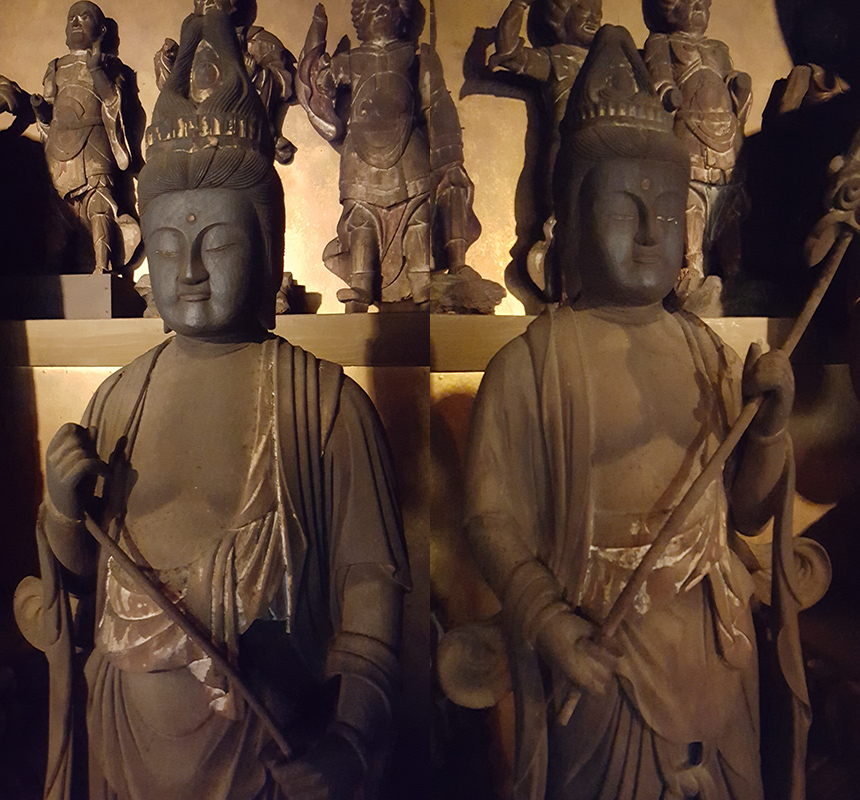Deities of Kunisaki and Beyond

Bosatsu
Bodhisattva
Second in hierarchy after the Buddhas are the Bodhisattvas, beings (sattva) seeking wisdom (bodhi). At early stages of Buddhist development, the title Bodhisattva was applied to figures like Manjushuri and Samantabhadra. Later, it was given to humans who made special contributions to buddhism, such as the 2nd ~ 3rd Century philosopher, Nagaruna; Asanga who lived 320 ~ 390 A.D.; and the 5th Century scholar and philosopher, Vasubandhu. In Japan, the imperial court sometimes gave the title to worthy personages such as Gyoki (668 ~ 749), Eison (1200 ~ 90), Ninsho (1217 ~ 1303) and Ryokan (1757 ~ 1831).
In Mahayana and esoteric Buddhism, many Bodhisattvas are considered emanations of certain Buddhas. For instance, the Buddha Amitabha is both compassionate and wise. Avalokiteshvara represents compassion; and another Bodhisattva, Mahasthamprata, represents wisdom. These three were originally worshipped as a triad. Later, Avalokiteshvara singularly became popular and worshipped widely in many different forms.
Kannon
Avalokiteshvara
Among the Bodhisattvas, Kannon has the largest number of forms and is the most venerated and popular Buddhist deity. This is probably because it is said that anyone calling on the name of Kannon will be saved from calamity, fear, theft and execution. His sex, originally masculine, is sometimes considered feminine. In China and Japan, Kannon has an ambiguous appearance. This perhaps stems from the conception of Kannon as ‘the mother of the human race’.
Kannon is known from the very early development of the Mahayana doctrines and, until Buddhism disappeared from India, enjoyed great favour there. His cult passed from India to South-East Asia through Nepal, Tibet and China, from where it passed on to Korea and Japan. Today, in Japan, there are more images of Kannon than of all the other deities in Japan. Kannon is the most popular deity in Tibet, under whose realm of protection the Tibetan region falls.
Nikko Bosatsu & Gakko Bosatsu
Suryaprabha & Canraprabhasana

Gakko Bosatsu is one of two acolytes, sometimes represented with Yakushi Nyorai. The other being Nikko Bosatsu. Gakko watches over mortals by night and Nikko by day. The triad are known as the Yakushi Sanzon. Both the Bosatsu stand with their hips gracefully swung to one side, a typical Indian posture. Nikko (sunlight) represents the idea that truth is always clearly apparent, while Gakko (moonlight) suggests that it is sometimes hidden from human eyes.
Senju Kannon Bosatsu
Sahasrabhuja Bohdisattva
Senju Kannon is the deity of pure bounty, omniscient and omnipotent. His thousand arms symbolise his ability to save all people from suffering. He fulfils all wishes, grants longevity, removes transgressions and cures illnesses. In reality, the image is usually given 16, 40 or 42 arms, which are normally arranged in a fan around the body.
Monju Bosatsu
Manjushri
Monju Bosatsu is, along with Fugen Bosatsu (Samanthabhadra), an acolyte of Shakyamuni. The three as a group are known as Shaka Sanzon, the three venerables of Shakyamuni, in Japan. Monju is the Bhodisattva of wisdom and one of four Bodhisattvas associated with Dainichi Nyorai (Vairocana). He symbolises the universal wisdom of Vairocana. Also, he is the supreme wisdom Prajnaparamita, in Japanese Chimyo-e.
Monju’s cult and images were introduced into Japan in 8th Century AD by Chinese monks who learned that Monju was reincarnated in the person of the Japanese monk Gyoki. The great monk, Saicho (767 ~ 822 AD) brought an image of a juvenile Monju from China and installed it at Enryku-ji temple on Mt. Hiei.
During the Heian Period (794 ~ 1192 AD), an effigy of Monju in monk’s robes was often placed in houses as a reminder of the wisdom and discipline which should be observed for the maintenance of the home. Later he was confused in the popular mind with Tenjin-sama, the Shinto deification of prime minister, Sugawara no Michizane. After the 12th Century AD, he was particularly venerated by the esoteric sects, especially Shingon.
His popularity has subsequently waned and now few temples are devoted to him. One of these is Kunisaki’s Monjusen-ji. Students believe that his worship can give them a gift for fine penmanship and guarantee success in examinations. A saying in Japanese relates that if three people put their heads together they could come up with something as wise as Monju might devise.
Monju is nearly always represented as eternally young, and seated. He holds the scroll of knowledge in the left hand and in the right, the vertical sword of wisdom which cuts through all ignorance and liberates the spirit from darkness.




